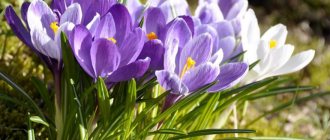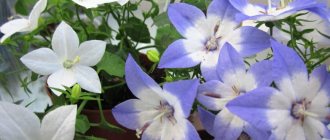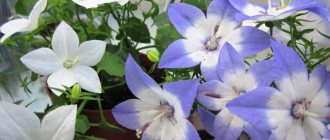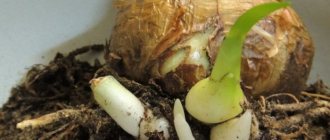Growing conditions
Let's find out where to plant spurge on the site, what conditions the plant needs for normal growth.
Location and lighting
Euphorbia should be planted in an area well lit by the sun. Garden spurge cannot tolerate shade and loses all its beauty and attractiveness in such conditions. If you plant a plant on the shady side of the site, the bush will not die immediately, of course, but it will turn out to be inconspicuous, low, and its leaves will be deprived of a white border. The lifespan of the flower will be significantly reduced.
Temperature and humidity
“Bride” is able to tolerate even severe drought and adequately perceives direct sunlight. But the plant does not like cold weather, which is why growing milkweed in the northern regions is problematic.
Humidity levels should be kept moderate. The shrub does not need too frequent watering and is afraid of prolonged rains.
Soil composition
It is better for milkweed to grow in dry, loose soil. Clayey, dense soil is not suitable. The soil should be fertile, but in moderation: the plant categorically does not tolerate excess minerals, especially nitrogen.
This is interesting: Blue phloxes: let's learn all the nuances
External characteristics
There are many varieties of milkweed, but only one of the species is called a bride - fringed milkweed. This species boasts small but multiple buds located at the very top of the shoots. The buds also have a white tint, however, the bush was not nicknamed the bride because of them. The unusual name is associated with foliage with a white border (see photo). It is interesting that at the beginning of their growth the leaves are evenly green; they acquire a white edge later.
The shrub is small in height, reaching only 80-90 cm. However, it grows very lush. The leaves are 6-8 cm long, the stems branch well. The buds and foliage of the plant are not at all afraid of the sun, do not lose their decorative value, and do not fade even in severe drought. Euphorbia blooms from July until the first autumn frosts.
Application
In landscape design, spurge is highly valued. With the help of this light plant you can make remote corners of the garden more attractive and elegant. Due to the peculiar white color of the bush, it is possible to achieve a visual expansion of the space.
In group plantings, euphorbia is usually used to separate those plants whose colors do not combine well with each other. Euphorbia itself in this regard has a rare versatility, but its variegated foliage looks especially impressive against the backdrop of red and blue flowers: roses, delphiniums.
Description of indoor campanula flower
The most notable thing for which this plant is grown is its flowers. Flowering is abundant and the plant is strewn with small star-shaped inflorescences. Their color, in addition to white and blue, can also be purple and pale pink.
With good care and comfortable conditions for this plant, it can bloom all year round. On average, its flowering period is from early spring to late autumn. This is exactly the quality that is valued in indoor plants - to bloom as long as possible.
The stems of the plant are thin and creeping, and can reach up to a quarter of a meter in length. Therefore, it is best to grow campanula in hanging pots. In this version, the plant looks very advantageous.
The leaves are light green in color and rounded-heart-shaped. They develop on petioles up to 7 cm long. This creates the impression of the splendor of the plant. The flowers seem to be surrounded by delicate leaves.
The inflorescences themselves are corymbose in shape and measure about 4 cm in diameter. They develop at the ends of creeping shoots.
Rich bride in landscape design
Designers treat the Rich Bride with special love. With the help of this easy-to-care flower, you can create extraordinary beautiful compositions in parks, squares, and flower beds. Milkweed is usually used to highlight distant areas of flower arrangements. Thus, the boundaries of the garden visually expand, which gives it even greater mysterious beauty.
When the color schemes of some flowers are incompatible, Euphorbia is used to remove the garishness of the composition and slightly dilute the edgy design move. This flower, which has an almost white color, looks great next to any plants. More often it is planted with red roses.
Euphorbia is used to make bouquets. In order for it to last longer in the vase, it is necessary to allow the white liquid to drain immediately after cutting the plant. To do this, the plant is placed in warm water and then dried in a well-ventilated area.
While watching the video you will learn about the described flower.
In general, Euphorbia is a very beautiful and easy-to-care plant. Leave some space in your flower bed this season and plant this stunning plant in late fall. Already in early spring, the first shoots will appear, which will grow and turn into a Rich Bride.
Flowers and Flowerbeds
Eco-friendly homestead: The rich bride is a flower that is quite easy to grow. The scientific name of the plant is Euphorbia marginalata or Euphorbia marginata. This is a beautiful lush annual, the height of which can vary from 30 to 80 cm, the leaves have an oblong oval shape, they are gray-green in color with a white edging along the edges, their size and shape can vary depending on growing conditions.
The rich bride is a flower that is quite easy to grow. The scientific name of the plant is Euphorbia marginalata or Euphorbia marginata. This is a beautiful lush annual, the height of which can vary from 30 to 80 cm, the leaves have an oblong oval shape, they are gray-green in color with a white edging along the edges, their size and shape can vary depending on growing conditions. The flowers are small, white, located at the top of the shoot. Euphorbia fringed blooms in mid-June, flowering continues until late autumn. Rich bride is an excellent plant for mixborders, borders, it feels great on alpine hills.
Euphorbia is a fairly unpretentious plant, but you need to know some growing features.
Euphorbia does not tolerate wet clay soil; the soil should be porous and light, mixed with sand or other baking powder. Euphorbia does not like frequent watering; water should not stagnate in the flowerbed, as this can lead to rotting. It is better to water the plant in the evening.
The Rich Bride prefers a sunny location, although the plant tolerates light shade. The more light the flower receives, the brighter and more beautiful the white edging will be. If you plant spurge in the shade, the plant may completely lose its beautiful border, and the shoots will become very elongated and become unattractive.
Euphorbia marginalata reproduces well by self-sowing, which is why it is called the “eternal bride.” If you purchased seeds for the first time, it is better to sow them before winter. When sowing in spring, you need to wait for warm weather, as young plants do not tolerate frost. The first shoots appear approximately 2 weeks after sowing. If you want to speed up flowering, you can grow seedlings, in which case the seeds are sown
Euphorbia marginalata reproduces well by cuttings; shoots are cut with a sharp knife and washed with hot water. This is done in order to get rid of the milky juice. Then the cut cuttings are dried for 20 minutes in the open air, after which they are planted in peat cups.
The soil for planting cuttings should be very loose, mixed with coarse river sand or perlite. Do not use yellow sand under any circumstances; it does not loosen, but clogs the soil, making it sticky and unsuitable for planting. Propagation by cuttings is used when several plants are needed in a short period.
This might interest you:
How to get a bumper harvest of large and sweet beets
How to propagate roses from cuttings in spring
The plant responds well to fertilizing with organic fertilizers. If you overfeed euphorbia, it will grow to the detriment of flowering. Knowing the simple secrets outlined above, you can easily master growing this flower on your site. published econet.ru
Features of reproduction
Euphorbia, when grown in the garden, can be propagated in two ways: seeds and cuttings. Let's take a closer look at both options.
Cuttings
This method is rarely used when growing milkweed, since it is more complex than the seed method. But if you still decide to take cuttings, get acquainted with the algorithm of the procedure.
- A cutting is cut that has at least one high-quality, developed bud.
- The shoot is placed in a glass of water so that the milky juice comes out of the cut. As long as the milky sap covers the cut, roots will not be able to appear.
- After the water procedure, the cuttings are dried by placing them in a dark and cool room.
- When the shoot dries, it is planted in a nutrient substrate in the open ground. Before rooting, it is better to protect the cuttings from adverse weather conditions with a cut plastic bottle on top.
Seeds
Euphorbia itself is capable of reproducing by seeds perfectly and without outside help. In a short time, this plant can fill all the nearby free space: if you are satisfied with this state of affairs, you won’t even have to help the shrub reproduce.
But if you want to approach seed propagation responsibly and create cultural plantings, use the following algorithm.
- Seeds are sown for seedlings in March; the soil should be moderately moist, nutritious and fairly loose. Euphorbia seeds do not need preliminary stratification.
- Before germination, the container must be insulated on top with film; after germination of the seeds, the cover must be removed. The first shoots should be expected approximately a couple of weeks after planting.
- If the seeds were planted in a common container, pick the sprouts at the stage of formation of the third or fourth leaf.
- When the threat of return frosts has passed, the seedlings are placed in open ground on a previously prepared bed. Depending on the climate of the region, planting outside is carried out from mid-April to the end of May.
Important: if you plant several specimens, leave a distance of 30 cm or more between them. Do not forget that the bush in adulthood becomes very spreading and voluminous.
You can plant seeds before winter, directly in open ground. Thus, during the winter, natural stratification of the seeds will occur, and in the spring the strongest and hardened ones will germinate safely.
We got acquainted with a unique plant, known to scientists as euphorbia or milkweed, and popularly known as the “rich bride.” There is nothing difficult in growing an unpretentious shrub: the main thing is to protect it from excess moisture and not to overdo it with nitrogenous fertilizing. Euphorbia will thank you for your care with lush flowering and will delight you with its beauty throughout the summer.
Good day everyone!
And especially for lovers of indoor plants. Although today, there are probably few people who do not have any plants growing on their windowsill. For one thing, everything is worth it.
It’s impossible to list all the types of indoor plants you can grow at home. But there are some that are traditional or popular, such as cacti. But today we will talk about campanula. This is the scientific name of the plant better known as "bride and groom" or housebell.
The plant has blue and white flowers. Blue flowers are called the groom, and white flowers are called the bride. It is grown both in separate pots (blue ones separately from white ones) and together, forming a kind of wedding flower, truly the bride and groom.
The plant is quite unpretentious in terms of care and will not bring much trouble. We will now look at how to choose a campanula, how to plant it and how to care for it.
Preparation for wintering and reproduction
The culture begins to bloom only after proper rest. To do this, it is necessary to carry out a haircut in the fall - the shoots are shortened to 10 cm. Then the flowerpot is moved to a bright and cool place, watering is reduced. Fertilizers are not required until March. In spring, dead shoots are cleaned out.
The lifespan of a bride flower is short and is only 3 years. Therefore, you need to regularly update and replant the plant. It is recommended to carry out the procedure in the spring. Gardeners distinguish several methods for breeding bellflowers:
By cuttings - the lower stems are divided into segments 10-15 cm long. It is advisable to treat the cuttings with a growth stimulator and then place them in a container filled with sand. You can create a greenhouse effect using film or a jar. The appearance of new leaves indicates the completion of rooting - the seedling can be transplanted to a permanent place. Young shoots - they can form at some distance from the bush in the spring
They should be carefully separated and transplanted into the substrate. For better survival, a greenhouse should be made before the first leaves appear. Dividing the bush is the fastest way to propagate Campanula.
During transplantation, you need to clear the roots from the soil and cut them into pieces with a disinfected knife. The cut site is treated with charcoal to prevent rotting.
Kalina Buldenezh
Garden flower yucca: planting and care
Viburnum variety Buldenezh (Snow Globe) is a perennial shrub with white, large (7-15 cm) flower caps. She is also sometimes called the bride.
Description and growing conditions
This is a tall (up to 3.5 m) shrub that begins to bloom in late spring - early summer. Not only its buds are decorative, but also its carved leaves. The crown reaches a diameter of 2-4 m. The older the viburnum is, the more abundantly it blooms.
The landing site should be slightly shaded. This could be the wall of a house, a fence, or a tree growing next to the viburnum. The soil should be light and loose; sand is added to the heavy one. Dolomite flour or lime is added to the acidified soil.
Planting in a dark area
Landing
Viburnum Buldenezh is planted in open ground in spring or autumn. Let's look at this process step by step.
- A planting hole is dug with a diameter 2 times larger than the root system.
- Compost is poured into the bottom of the pit, then the prepared substrate.
- A depression is made in the middle into which the seedling is inserted.
- The roots are straightening out.
- The remaining soil is filled in, which is then compacted and watered.
The tree trunk circle is mulched to protect the root system from drying out and retain moisture in the soil.
Care
Viburnum Buldenezh loves abundant watering, especially the amount of moisture you need to monitor while the bush is young. In the year of planting, the bride is not fed: the fertilizer that was poured into the planting hole is enough for her. Organic matter is added next spring, and complex fertilizer is applied in the fall.
Important! Before applying fertilizer, in order not to burn the roots, the soil must be shed with water. You should water again after application so that the nutrients reach the root system faster.
After flowering, formative pruning is performed. All branches with buds are pruned so that young shoots grow, on which white balls form next year.
Like many green spaces, viburnum Buldenezh sometimes gets sick and is also attacked by pests. It is better to prevent these misfortunes by spraying the bush with approved chemicals in the spring.
Reproduction
Starting in spring, viburnum Buldenezh is propagated by layering. To do this, the lower branches are bent to the ground, fixed with something, and compost is poured on top.
Compost
The rooting site is well watered. The shoot is usually ready for independent life by next spring. Together with the root, it is separated from the mother plant and planted in a permanent place.
Another method of propagating the bride is cuttings. For these purposes, in June, shoots with 2 pairs of buds are cut and rooted in moist soil, covering them with a transparent cap. The greenhouse is constantly ventilated, the cuttings are regularly watered. When roots form on them, they are transplanted into a school for growing, and after a year they are planted in a permanent place.
Basics of growing and caring for flowers
This unpretentious plant will delight its owners for a long time with abundant flowering if the following growing conditions are met.
Choosing a place in the house
Incorrect location of the pot leads to loss of decorativeness of the plant: with sunburn, translucent spots of indeterminate shape appear. At the same time, spraying accelerates their formation. Lack of light manifests itself in the development of thin, weak leaves on elongated shoots. Based on this, the right solution would be to place a pot with a flower next to a window with an eastern or western orientation. Installation on a southern window sill will require the installation of protective equipment in hot weather.
To obtain a beautiful, symmetrical bush, experienced gardeners recommend turning the pot every week at a slight angle.
Temperature
The optimal temperature conditions for the bride flower are 20-25 °C in summer and about 15 °C in winter. The flower pot should not be placed in drafty areas. It should not be placed near vines. The shoots of the plant must not be lifted up or attached to a support.
An important element of care is the timely removal of yellowed leaves and shoots. If the main stem becomes diseased, it is recommended to completely remove it without damaging the young shoots. In summer, it is useful to take pots with plants out onto the balcony or into the garden.
Choosing a pot and soil
For a convenient location of the roots (they grow quickly), a low and wide container is selected. Having made high-quality drainage, the container is filled with loose, breathable, slightly alkaline soil. If you prepare the soil mixture yourself, take equal parts of peat, humus, leaf soil, and sand. If necessary, soil is purchased in shopping centers. The composition is intended for decorative flowering species.
The first sign of an urgent plant transplant after purchasing it in a store (flower market) is the appearance of dried buds. It is better if this is done in the spring or autumn.
Watering and humidity
An indoor bride flower can do without daily watering for some time (which is convenient for travel lovers and busy owners). In the summer, when the bush sparkles with bells, it is better not to leave it for long
It is very important to monitor the condition of the soil in the pot. It should not be too dry and with excess water in the pan
In summer, the plant is watered once every two days. In the cold season, no more than once a month. The flower is at rest at this time.
Important! The bride flower is prepared for winter in October as follows: long shoots are cut to 10 cm, and a cool room with lighting is found. Use soft, settled water for irrigation at a temperature of about 22-24 °C. Along with watering, fertilizing with fertilizers for flowering plants is combined.
During the period of active flowering, this must be done at least once every 2 weeks.
Use soft, settled water for irrigation at a temperature of about 22-24 °C. Along with watering, fertilizing with fertilizers for flowering plants is combined. During the period of active flowering, this must be done at least once every 2 weeks.
Violation of the correct watering regimes (for example, waterlogging of the soil) provokes the development of rot and fungal diseases. At the same time, the stems and leaves turn black and the flower dies. It is impossible to do without the use of fungicidal drugs.
Standard air humidity values of 40–50% provide normal conditions for the development of campanula. During the summer heat, the flower can be sprayed, but make sure that water does not get on the inflorescences. It is better to put moss in the pot and maintain moisture by watering it.
When kept in too dry air, scale insects and spider mites appear on plants. They get rid of them with the help of actara, fitoverm, actellik and other drugs. Folk remedies often use soap solution, medical alcohol, infusion of onion and garlic.
Reproduction
Those who wish to plant several specimens of the bride or groom can use any of the propagation methods for this: seeds, dividing the bush, cuttings, one-year shoots.
Note! Flowers form on young shoots of plants of any age. To have more of them, the flower needs to be trimmed annually and updated frequently
By using simple techniques for growing indoor flowers, the bride and groom can constantly admire the beautiful delicate inflorescences. Belief in the eternal legends about the flower (which gave them the opportunity to be called the bride and groom) will strengthen family relationships, fill them with care, happiness, and love.
Reproduction of ornamental plants
The owners of the flower, the bride and groom, regularly face the need to reproduce it. This can be done at home using cuttings. In the spring, select and cut off young healthy branches 10 cm long from the plant. Place them in water for a while and wait for the roots to appear or treat them with Kornevin. Flower growers advise planting several cuttings at once in one pot. After this, the soil should be spilled with phytosporin, and the container itself should be covered with film (the optimal temperature inside is about +13 ° C).
Advice. When it reaches 12 cm, pinch the cutting. This way you will stimulate the side shoots, and the greenery will turn out more luxuriant.
Water and ventilate the bride. After about 20-25 days, the greenhouse can be dismantled and the pot sent to the windowsill. The bride is also propagated by dividing the bush. At the last stage of flowering, cut off all the greenery at the root and wait for green shoots to appear. After this, the bell can be divided.
Gardeners successfully grow campanula indoors. The bride needs simple care, plenty of water and normal lighting. In addition, do not forget to remove dead greenery and faded buds from time to time to maintain the decorative appearance of the flower throughout the season.
Feeding, pruning
If the land on your site is very fertile, then Euphorbia marginalata does not need to be fed. If the soil is depleted, fertilize it with mineral or organic fertilizers. An excellent option is a manure solution. To prepare it, dilute 200 grams in 10 liters of water, stir the substance well, and leave for a day. The soil is fertilized with this solution in the evening.
The snow-like Euphorbia marginata is a member of the Euphorbia family, which means its juice is poisonous. Pruning this plant almost to the root. If a lot of root shoots have formed over the summer, cut off the excess ones too.
The most beautiful Snow on the mountain does not get sick and is not attacked by harmful insects. The plant is protected from the latter by poisonous sap, and its resistance to diseases is due to its powerful immunity. Euphorbia marginata successfully tolerates even bad weather, if it is not prolonged rains.
Such a beautiful flower is widely used in landscape design because it combines well with other garden crops. It looks no less excellent as part of bouquets, especially together with delphinium, mallow and dahlias.
Olga Danilina
What to do if the Bride does not bloom
Sometimes it happens that the plant “refuses” to bloom. This situation can arise for several reasons:
- The bluebell grows in a larger pot than it needs. To produce many buds, you need a tight pot.
- The plant lacks certain substances to flower. During the period of increased growth, the Bride needs to be fed 2 times a month.
- Timely pruning is not carried out. Buds do not form on woody shoots, so the campanula needs to be rejuvenated annually.
- Sometimes the reason lies in improper placement of shoots. By nature, they should hang down, so any attempts to lift them up may be accompanied by a negative reaction from the plant.
The bride is an amazing flower that, with proper care, can give beauty and extraordinary tenderness. In return, it will not require special attention, so anyone can grow it.
The rich bride is a flower that is quite easy to grow. The scientific name of the plant is Euphorbia marginalata or Euphorbia marginata. This is a beautiful lush annual, the height of which can vary from 30 to 80 cm, the leaves have an oblong oval shape, they are gray-green in color with a white edging along the edges, their size and shape can vary depending on growing conditions. The flowers are small, white, located at the top of the shoot. Euphorbia fringed blooms in mid-June, flowering continues until late autumn. Rich bride is an excellent plant for mixborders, borders, it feels great on alpine hills.
Euphorbia is a fairly unpretentious plant, but you need to know some of the growing features. Euphorbia does not tolerate wet clay soil, the soil should be porous and light, mixed with sand or other baking powder. Euphorbia does not like frequent watering; water should not stagnate in the flowerbed, as this can lead to rotting. It is better to water the plant in the evening. The Rich Bride prefers a sunny location, although the plant tolerates light shade. The more light the flower receives, the brighter and more beautiful the white edging will be. If you plant spurge in the shade, the plant may completely lose its beautiful border, and the shoots will become very elongated and become unattractive.
Euphorbia marginalata reproduces well by self-sowing, which is why it is called the “eternal bride.” If you purchased seeds for the first time, it is better to sow them before winter. When sowing in spring, you need to wait for warm weather, as young plants do not tolerate frost. The first shoots appear approximately 2 weeks after sowing. If you want to speed up flowering, you can grow seedlings, in which case the seeds are sown at the end of February or at the beginning of March, it all depends on the region in which you live.
Euphorbia marginalata reproduces well by cuttings; shoots are cut with a sharp knife and washed with hot water. This is done in order to get rid of the milky juice. Then the cut cuttings are dried for 20 minutes in the open air, after which they are planted in peat cups. The soil for planting cuttings should be very loose, mixed with coarse river sand or perlite. Do not use yellow sand under any circumstances; it does not loosen, but clogs the soil, making it sticky and unsuitable for planting. Propagation by cuttings is used when several plants are needed in a short period.
The plant responds well to fertilizing with organic, potassium and phosphorus fertilizers, but you need to be careful with nitrogen; if you overfeed the spurge, it will grow to the detriment of flowering. Knowing the simple secrets outlined above, you can easily master growing this flower on your site.
Reproduction methods
Campanula can be propagated in different ways. The following methods are used in indoor floriculture:
- seed propagation - seeds are sown in a loose and abundantly moistened substrate, covered with film for the period of germination. Ventilate periodically. After emergence of shoots, the film is removed;
- cuttings - cut cuttings are treated with growth stimulants and deepened into the soil at an angle of 2 cm. For better germination, cuttings can be placed in water for several days, and only then planted. Propagation by cuttings is inferior in germination to seed propagation, but gives faster results;
- Dividing a bush is an easy way to get a mature plant ready to flower. But the bell is considered fragile, and therefore dividing the bush should be done carefully. The earthen lump is moistened abundantly, then removed from the pot, the rhizome is divided into the required number of parts and planted in new bowls.
Description and characteristics of the flower bride
Campanula has many varieties, but only one is grown indoors - Campanula equifolia. It belongs to the herbaceous flowering perennials. Bride characteristics:
- stems - thin, creeping, up to 25 cm long;
- The leaves are small, heart-shaped, rounded, with long petioles. Placed on the shoot alternately;
- The flowers are bell-shaped, up to 4 cm in diameter, and consist of 5 petals. Collected in 2-4 pieces. at the end of the stem.
Reproduction
If the plant has grown enough and does not fit into the volume of the container, it must be divided into several parts. Carefully remove the bush from the pot with a lump of earth. Using a sharp knife, the rhizome is cut into pieces.
Don’t forget to treat the cut areas with crushed wood charcoal. Plant the resulting parts in new containers of smaller volume. It is not recommended to immerse plants deep into the soil. Immediately after transplanting, provide the plant with plenty of water and shade.
Using cuttings
Campanula cuttings
- Cuttings are very easy to obtain. When pruning elongated shoots, use the lower parts for rooting.
- Rooting occurs best in a mixture of peat and sand.
- For cuttings, it is necessary to provide greenhouse conditions; it is advisable to cover the plant with a polyethylene cap and regularly spray it with water from a spray bottle.
- The optimal rooting temperature is 20 - 24°C.
- After the shoots grow to 7 - 10 centimeters, pinch their tops. This procedure provokes the appearance of additional shoots. Your bushes will be more branched.
Cuttings can be resorted to in the summer. They will grow over the summer and autumn, but by the beginning of winter the green part needs to be cut off and the flower allowed to rest. Already in the first spring after transplantation, campanula can bloom with proper care and timely feeding.
Green shoots
This type of vegetative propagation should be resorted to in the spring, when young green branches grow at the campanula. They can be cut and rooted.
How to do it correctly:
1Separate the green shoot from the “heel”
2Plant it in a mixture of loose peat soil and sand
3Cover with plastic wrap
4Ensure greenhouse conditions
5Keep the container with young shoots in a cool place at a temperature of plus 12-15 degrees
6Don’t forget to spray and ventilate your miniature greenhouse every day
Mini greenhouse for rooting cuttings
Campanella takes root quite quickly; after two weeks, small roots form. After the plants begin to actively grow vegetative mass, move them to a brighter and warmer place.
When the plant reaches a height of ten centimeters, it is necessary to pinch it so that it begins to branch and bush.
Propagation by seeds
The seeds of this plant are very small; they need to be planted superficially in small bowls filled with soil mixture. It is advisable to cover the seeds with a thin layer of soil on top. For seeds during the germination period, it is necessary to provide a greenhouse effect, wrap the top with plastic film or glass.
Sprouted seeds
Be sure to provide periodic ventilation to prevent excess condensation from accumulating. After the third leaf appears, pick up the seedlings, do not forget to pinch, this will allow you to get a branchy bush. Plants grown from seeds usually bloom in the second year.
Growing Lavender from seeds at home: description, varieties, planting and care, stratification | (50+ Photos & Videos) + Reviews
Musk mallow
It can also be called mallow. This is one of the elegant garden perennial plantings. It begins to bloom the next year after planting.
Mallow
Characteristics and growing conditions
Garden hibiscus flower
The bride is called musk mallow of the Alba variety. This plant is about 1 m high. It not only has beautiful, but also fragrant flower buds. Outwardly, they are a little similar to Chinese rose flowers; they reach 5 cm in diameter.
The area for planting mallow is chosen to be well-lit and protected from drafts. In the shade, this planting will not bloom so spectacularly. The soil should be enriched with nutrients and loose.
Attention! The landing site must be chosen immediately. Due to its branched root, mallow does not tolerate transplantation well.
Care
The perennial garden bride flower is easy to care for and does not have any special requirements for maintenance. The measures that need to be taken for good growth of the bush are as follows:
- moderate watering as needed;
- spring application of organic matter will contribute to the abundant formation of green mass and buds;
- after watering, the soil is loosened;
- overgrown shoots are tied to a support;
- after the buds have bloomed, they are removed so that the mallow does not waste energy on forming seeds;
- in the fall, after the end of the growing season, the above-ground part is cut off.
- In winter, the root area is mulched, covered with spruce branches, sawdust, and leaves.
The garden flower perennial bride is rarely susceptible to diseases, but if there is an excess of moisture, there is a danger of infection by various fungi. To eliminate them, the planting is sprayed with a fungicide. Aphids or spider mites can also cause damage. To get rid of them, mallow is treated with an insecticide.
Don't forget about moderate watering
Reproduction
The most popular method of propagation is by sowing seeds in spring, in loose, nutritious soil. Small furrows are made, watered, and seeds spill into them. From above they are covered with a thin layer of soil. After 3 weeks, the first shoots will appear. Musk mallow will begin to bloom in a year.
If a gardener gets one bush of this plant, you can try to propagate it with cuttings. Here's how it's done:
- the stalk is cut off with a sharp tool;
- dipped in crushed coal;
- left for some time to dry;
- planted in a small pot, at the bottom of which drainage is placed and watered;
- The top of the plant is covered with plastic film.
Important! The cutting tool must be well disinfected.
The perennial bride flower can be planted in the garden alone or in combination with other green spaces. It will give the garden solemnity and elegance. With proper care, it will grow in one place for a long time and delight others with spectacular flowering.
0 0 votes
Article rating
Flower “Bride and Groom”: care at home
Caring for the Bride and Groom flower is considered quite simple.
Bluebells are lovers of cool places, so in rooms with a cool climate the plant behaves as if it were absolutely unpretentious. It is best to choose eastern and western rooms, while avoiding the southern sides. In summer, the campanula can be taken out to live on the balcony. To make the flower feel comfortable, the room needs to be aired daily. Bells love light, but it is better not to place them on the windowsills of windows facing south. The heat will not be the best ally for the “bride and groom.” When the room temperature is about 16-20 degrees, the campanula grows in full force, feeling very good. But in the summer, when it’s hot and stuffy outside, the flower can get sick. It should be watered abundantly during the active growing season. When the plant goes into hibernation, that is, a period of rest begins, it is advisable to reduce watering. In summer, water once every three days, and after flowering, once every 7 days is enough. For reference, the dormant period for such flowers falls at the beginning of December - mid-January
When watering, you can use hard water, but follow the rule: the hotter the room, the more often you water. Caring for the “bride and groom” at home requires mandatory spraying on hot days and in the first days of the heating season. In the summer, when Campanula actively blooms (June - August), it is very important to fertilize. It is best to do this 1-2 times a month with organic fertilizers. At the end of winter or spring, it is advisable to trim the shoots, leaving sections with 2-3 dormant buds
It is important to ensure that these same buds do not become lignified. Otherwise, the plant will simply lose its ability to bloom. To achieve lush flowers, you need to remove wilted flowers in time.
The popular name “Bride and Groom” was assigned to Campanula Campanula. These plants reach a height of no more than 30 cm. Light green leaves are located on thin, hanging down or creeping shoots.
From June to October the plant blooms profusely. Many bells appear on it. The diameter of which, as a rule, does not exceed 4 cm. It is customary to distinguish the groom from the bride by the color of the flowers. The bride's flowers are white, and the groom's flowers are light blue. There is a tradition to give newlyweds 2 flowers (necessarily male and female, 1 each), then the family will be strong, and love and happiness will never leave it.
In order for flowers to look appropriate for their status, they need to be grown correctly. The location on the north or south side is not of fundamental importance. Even-leaved bells love diffused, dim light. These plants are ampelous, so it is advisable to grow them on a stand or in a flower pot so that the stems can hang down freely.
Flowers "Bride and Groom" need good watering. It should be daily and plentiful. In summer, the plant is watered 2 times a day.
While the bells are developing and growing, they need to be fed once every 10 days with liquid fertilizers for violets “Kemira-Lux” and “Etisso”. Instead, you can use complex fertilizers for indoor plants.
Excessively overgrown lashes must be trimmed. The procedure is carried out after the plants have finished flowering. The upper shoots are removed almost to the base, and the lower ones are shortened, leaving only 10 cm shoots. In this form, the flowers can go on winter rest.
The dormant period lasts about 2 months - from the end of October to the end of December. The place should be dry, bright and cool. The air temperature should not be higher than +15 C. During this period, the plant is not fed, and watering is reduced to 2 times a month.
At the end of March - beginning of April, the bride and groom's flower is ready for transplanting. For the procedure, purchase in advance soil intended for replanting azaleas.
Spring is a good time for propagating even-leaved bells; use apical cuttings, 10-20 cm young shoots (tear off young shoots at the heel) or dividing the bush. In the latter case, do not divide the bush into too small parts.
Bride and Groom are different varieties of Campanula equifolia that are not suitable for planting together in the same pot. White plants are stronger and will quickly displace their blue neighbor.
General description of the plant
Another name for the flower in question is Euphorbia Mountain Snow. It is an annual plant found naturally on the mountain slopes of North America. The bush grows up to 80 cm in height and is highly branched. Its main decoration is leaves. In spring, they are not of particular decorative value, since they are gray-green in color. The leaf blade is oval, slightly pointed or rounded.
The plant transforms immediately after flowering begins (June-July) - the leaves change color and a wide white edge appears on them. Flowers are collected in inflorescences at the ends of the shoots. The variety grows quickly, has a powerful root that spreads throughout the surrounding area. In September, self-sowing of grain-like seeds occurs.
Some gardeners confuse Euphorbia marginalata with the Bride and Groom flower. You can see the visual differences in the photo. The latter is planted in pairs, combining varieties with white and purple buds. The plant is usually grown at home and is considered a symbol of family happiness.
You should remember the name of the Bride and Groom flower, so as not to get confused when purchasing and planting. Officially, the species is called Campanula and belongs to the Campanula family.
Varieties and varieties
Today there are about 20 varieties of this flower, but in dachas no more than 4 of them are mainly grown. The most common types are angustifolia and graceful zinnia. It was this that served as the basis for the development of numerous hybrid varieties.
Zinnia graceful
This is a herbaceous annual plant, the height of which can exceed 100 cm. The inflorescences are colored pink, white or orange. As a rule, the shoots are straight and not branched; their cross-section is characterized by a rounded shape. The leaf blades have pubescence consisting of rather hard hairs. They are ovoid, length varies between 50-70 mm, width no more than 45 mm. Basket-shaped inflorescences form at the tops of the stems. The diameter of the flower reaches 5-16 cm, the surface can be double, semi-double or simple. The color is very diverse, even blue zinnia is found. The plant begins to bloom in early June.
Based on the height of the shoots, this variety is divided into:
Zinnia graceful
- undersized, also known as dwarf zinnia. The height of the stem varies between 15-30 cm. A bushy branching plant is formed and looks very attractive. Can be planted in pots and open ground.
- the average one has a stem height of 35-50 cm. It is grown in flower beds and is often used for cutting into bouquets.
- tall zinnia grows up to 90 cm. It is planted exclusively for cutting, since in flower beds due to its large growth the plant looks sloppy.
Zinnia dahlia
The flower differs from its relatives in its powerful bushes, which can be compact or spreading. Their height varies between 60-90 cm. Shoots are formed of the first order. The massive foliage reaches 12 cm in length. The diameter of the hemispherical double inflorescences reaches up to 14 cm. The most popular varieties of this variety are:
- Zinnia Dreamland is a double varietal flower that grows in height up to 65-70 cm. The inflorescences are formed quite dense, the color can be very diverse;
- Zinnia Miss Butterfly amazingly transforms the garden plot during flowering. The height of the plant is no more than 0.7 m. The inflorescences reach 14 cm in diameter and have a rich orange-red color;
- The polar bear grows as a compact bush, no more than 65 cm in height. The inflorescences are densely double, rich white in color with a greenish tint.
Zinnia Lilliput
She's pom-pom. It is distinguished by its attractive compact appearance, its height is no more than half a meter. A large number of shoots of the second, third and even fourth order are formed. The leaves are miniature.
Note! The inflorescences are also relatively small in size. Does not exceed 5 cm in diameter
The most popular varieties of zinnia lilliput:
- Zinnia Magellan. The height of the bush is no more than half a meter; during flowering, deep red, scarlet, densely double inflorescences are formed. The shape of the flowers is truncated-conical or round;
- California zinnia grows as a compact bush, the height of which does not exceed 45 cm. The color of the inflorescences is bright red, the surface is terry, the shape visually resembles a flattened ball;
- Mixed tambelina reaches a height of about half a meter, the inflorescences can be of different colors. The diameter of the flower varies between 40-60 mm.
Zinnia angustifolia
This variety comes from Mexico. This erect plant belongs to the group of annuals; in the process of its growth and development it forms branched bushes. The leaf blade is elongated and has a pointed or lanceolate shape. During flowering, deep orange inflorescences are formed; the surface can be ordinary or terry. Known varieties:
- Cherry is a highly branched bush, the height of which does not exceed 25 cm. The surface of the inflorescences is terry, the base of the reeds is dark orange in color, and the tips are brown-red;
- white, lemon or yellow zinnia belongs to the Persian Carpet Mixed series. Sold as a mixed seed mixture. These are semi-double bicolor hybrids. The bushes form quite massive, visually reminiscent of oriental carpets;
- Zinnia Swizzle reaches a height of no more than 30 cm. The stems are highly branched and creeping, but rather weak and thin. Inflorescences are formed in white, yellow or orange. In most cases, this variety is grown as a ground cover crop.
Varieties of flowers
The Mediterranean coast is considered the birthplace of Campanula. The most common habitat is mountainous terrain.
There are more than 300 varieties of this plant in nature, but only one is grown on the windowsill. But based on it, breeders have developed many hybrids of different colors and shapes.
True, not everyone takes root on window sills. Most grow like this in nurseries. But the most resilient ones settle in our apartments. And the point here is not about care, but more about characteristics.
There are such main varieties as equal-leaved and double-leaved. Terry ones are becoming increasingly popular due to their beautiful flowers, in contrast to the classic bell-shaped varieties.
Campanula terry
The variety was developed as a result of crossing Carpathian and portenslag Campanula. The flowers of the plant are medium-sized, double and resemble small roses. The branches of the variety are persistent and can stretch to a certain length without falling down. The most popular flower colors are the classic ones: blue and white. However, there are both pink and pale blue ones.
Unlike other varieties, terry campanula is quite finicky, which limits its cultivation at home.
Campanula terry mini
It is similar to terry campanula, but with flowers of a smaller, almost miniature size - up to 1.5 cm.
The lashes, unlike the previous variety, are somewhat shortened and always raised upward. The leaves, like the flowers, are small. The color can also be from standard white and blue to blue and pink. Bicolor varieties are also grown - blue and white. The flowers also look like miniature roses.
Alba and Maya
The most popular and, accordingly, found mainly on the windowsills of flower lovers are two varieties - Alba and Maya. As the name of the Alba variety says, its flowers are white, while the Maya variety has blue flowers.
The branches of these varieties reach 30 cm and hang freely from the pot, which allows them to be grown in flowerpots. These are such popular and most commonly grown varieties that the name Bride and Groom was given to them.
Another interesting species is Pozharsky's bell
There are several varieties of this species. But they all have almost the same characteristics. The leaves are large and located on small stems up to 20 cm. The variety can be grown both in pots and in open ground.
The flowers are star-shaped and often don't even look like a bell. The color can be very diverse: from white to blue with a purple tint.
Portenschlag Campanula
This variety is more suitable for growing in open conditions, but it is also beautiful in potted form. When grown in a pot, the plant forms something like a dome over it. The stems of the plant are short, up to 10 cm. At their tops, single flowers are formed, shaped like an open bell. The size of the flowers can reach up to 2.5-3 cm, their color is white or blue. The leaves sit on long petioles and have a jagged pattern along their edges. They have a round or heart-shaped shape.
Napoli and Atlanta
Two more varieties that are close to Alba and Maya are Napoli and Atlanta.
The plants have low bushes with erect stems. The leaves are medium in size, heart-shaped and light green in color. The flowers are large – up to 3 cm and vary in color. The Napoli variety has blue and even purple flowers, and Atlanta has white flowers. Moreover, they differ in the method of cultivation. If Napoli is more of a garden and flower bed flower, then Atlanta is exclusively an indoor plant. Although Napoli can also be grown indoors.
Campanula Carpathiana or Carpathica
As for the wilder variety, which served as the beginning for many varieties of campanula, this is the Carpathian campanula or Carpatica.
This bush-shaped herbaceous plant was found in the Carpathians, hence its name. The variety is frost-resistant down to –40 °C and can be grown both in pots and in open ground.
The height of the plant reaches up to 30 cm. The leaves are oval and arranged in the form of a basal rosette. The flowers are large, reaching a diameter of up to 6 cm. Their colors are white, blue, lilac and violet. Flowering occurs under natural conditions from May to August. True, having removed the species from the natural environment, a more garden variety was bred. In the wild, the Carpathian bell does not have a very attractive appearance.
These are the main varieties of this plant found in stores or among amateur gardeners. If you decide to have such a plant “pet”, then purchasing it will not be difficult. Moreover, classic varieties are always available in the store or at one of your friends and relatives.
Having purchased such a flower, you will not feel much trouble with it, since the main thing it requires is watering. However, this requirement is typical for all plants.











